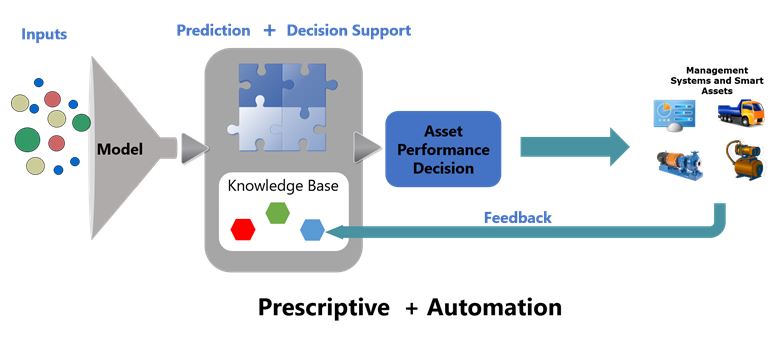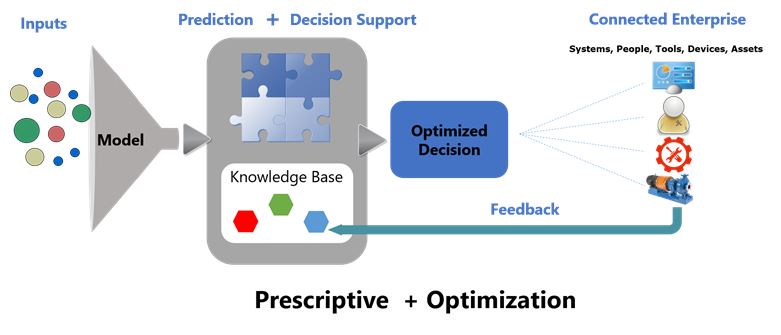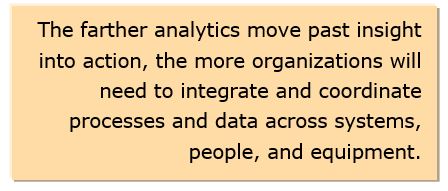

Industrial companies increasingly compete in markets affected by globalization and rapid technology advancements. To survive and thrive in these markets, these companies are attempting to leverage massive amounts of data.
Using interconnected equipment, devices and systems, organizations can collect a wealth of real-time data about their operations. Historic data, collected and unused often for decades, can also be mined for new value. Massive amounts of unstructured data, such as video, audio, work logs, manuals, paper work order documents, can be integrated into analytics.

Yet even as companies wrestle with how to implement and leverage predictive solutions, a new layer of the analytics “onion” is already being peeled—prescriptive analytics. While predictive analytics determine the probability that something will happen, prescriptive analytics provide guidance as to what should be done in response and can often automate the outcome.
Companies desire to layer prescriptive analysis on top of predictive methods. The idea is to maximize the use of data to predict what might occur and then act upon that prediction to deliver the optimized outcome for the business. The beneficial implications of employing this approach to decision making could transform how business is done.
This report addresses the uncertainty around prescriptive analytics, clarifying the different modes and how they work. The report outlines the market use of these modes, clarifying level of complexity and current adoption. It will provide strategies intended to help you understand how to think about prescriptive analytics within the context of your business.
We are having many discussions with buyers looking for clarity on how to make purchasing decisions for advanced analytics, including both predictive and prescriptive methods. Many are confused and even skeptical, and for good reason. The market lacks clarity. Reasons include:
ARC Advisory Group uses three major categories to describe the business intelligence and analytics market. In this definition structure, the two best-understood types, descriptive and discovery, are combined into the performance analytics category, which is often referred to as business intelligence.

Performance analytics include descriptive and discovery solutions. Descriptive analytics look at past performance data to show what happened. It provides visualization of a statement of fact. A couple of common styles used to present information this way are static reports and static dashboards. These analytics don’t provide any way for a user to drill down into the data.
Discovery analytics introduces correlation. Using the same examination of past performance as descriptive analytics, it begins to address the “why” of something occurring. Together with descriptive analytics, they form the pillars of business intelligence.

A good example of this combination begins with descriptive analytics that identify consistent seal failure in water injection pumps on an oil platform. By adding discovery analytics, the business may then connect the performance to other factors, such as equipment manufacturer, crews installing or maintaining the asset, condition of use, etc.
Predictive analytics, a type of advanced analytics, focuses on future performance. It is best described as inductive, as it looks at new data to determine the probability of something occurring. Predictive analytics leverage historical and real-time data, and many solutions also use structured and unstructured forms.
Machine learning is often used for predictive analytics. As it ingests large amounts of data, machine learning can identify discriminative patterns that identify the probability of a behavior occurring, such as an asset failing. Machine learning techniques can adapt to incorporate new behaviors and data sets.
Forecasting is a common example of predictive analytics. Another is using a wide range of historical and real-time data, both structured and unstructured, to predict gearbox failure in a renewable energy wind turbine. Provided the risk for failure is identified in a timely enough manner, operations and maintenance can take action to avoid asset failure.
Prescriptive extends the process started in predictive analytics (it can also do the same for discovery analytics). It does so by weighing options for problem solving, suggesting an ideal approach and, to varying degrees, integrating action as part of the analytics. The key difference from predictive solutions is that these analytics can weigh potential outcomes to determine ideal actions without needing human intervention to do so.
A commonly understood example of prescriptive analytics is a self-driving car, which continually optimizes decisions, such as turn right, turn left, slow down, or stop. Of course, as has been shown in pilot projects with self-driving cars, the results aren’t always perfect.
A good industrial example is continual optimization of workflow and goods across delivery or maintenance processes. As new uncertainties and constraints impact the environment, the analytics model can continually prompt the correct decisions across workflow. The more optimized actions that are driven into those processes—work, mobility, supply chain, customer service, etc. — the more prescriptive (and valuable) the analytics become.
The lines often are blurred when distinguishing predictive from prescriptive analytics. Most often, it occurs when an analytics solution is described as having a closed-loop component. In many instances, the closed-loop process is described as prescriptive analytics. That is not necessarily accurate.

On the other hand, prescriptive analytics are by their very nature closed-loop in that they provide specific guidance for human actions or automate a specific outcome. Like predictive analytics, they can ingest data and identify patterns. However, they also consider options, determine the ideal action to take, and can invoke that action. Thus, prescriptive analytics remove the barrier between the insight gained and the action taken.

When predictive analytics are misidentified as prescriptive, it usually occurs because of two capabilities that are characterized as proactively solving a problem:
Prescriptive analytics build upon other types—descriptive, discover, and predictive—by adding answers as to what should be done. Prescriptive analytics differ from other forms of analytics in that they contain both a knowledge base and decision support automation. The knowledge base ensures that the correct remedy is identified; the automation helps carry it out.
In combination, those components ensure that the analytics move from “actionable insight” to “insight plus informed action.” Currently, prescriptive analytics are most effective when the desired outcome of the analyzed process is very clear. An example is the timely and accurate delivery of a package to a pre-defined address or applying a specific maintenance strategy. Using historic data, applying prescriptive analytics is much simpler.
Consider an example of a prescriptive method built upon discovery analytics. For an asset performance management application, the analysis could incorporate data such as performance rules, inspection-based confidence ratings, warranty maintenance schedules, condition of use, and work history. Based upon analysis of this historic data, a performance anomaly is isolated. As an example, it could be identifying high failure in assets of a certain make and models when operating at a specific cycle under certain conditions.

The automated process can also identify the risk and work priority level. It can support the planning, scheduling, execution, and close out of the work. The result is a continuum; from the insight and prescriptive action being identified, to the work being completed.
In industrial settings, the use of prescriptive analytics built upon prescriptive models is still in its formative stage. Prescriptive approaches must be able to determine what action to take without the certainty of hindsight. In this situation, risk can be heightened as decisions are being made based upon the probability of what might occur. Contrast this to prescriptive solutions based upon historic performance, where actions have occurred and outcomes are verifiable. Though reactive by nature, when used only with historic data, it’s usually easier to identify prescriptive remedies.
Layers of prescriptive analytics can be built upon a predictive model. Beginning with the building block of the predictive analytic, common modes of advanced prescriptive analytics can be identified.
The building block for prescriptive solutions is the predictive analytics mode. As discussed, this mode is often put forward as prescriptive under the guise that it can automate an alert or prompt. However, it is not supported by a knowledge base and so is not prescriptive.

An example is predicting failure for utility-scale wind turbines. Structured and unstructured data is ingested: asset nameplate, blade angles, historian information, current and historic weather, pictures and video, maintenance records, technician notes, etc. Analysis detects anomalies. An alert is then pushed to a device or a system where it can be viewed by people.
Once detected, the alert prompts a person to invoke inspection or maintenance planning and scheduling. In this way, issues such as gearbox failure can be identified months in advance and remedied through maintenance or replacement.
The initial prescriptive analytics mode advises people as to what should be done to prevent or reduce risk. It does so by leveraging a knowledge base that has processed options and determined a corrective action, such as optimized maintenance strategies. It automates the delivery of the prescriptive action to a person or people that can then execute the work.

A good example is the use of analytics to support routing for field work. Analytics are continually employed to optimize a route in real-time. Any number of static and dynamic external factors can be considered.
Third-party data can be incorporated, such as traffic, weather, and construction. Using straightforward analysis, ideal routes are suggested and acted upon by drivers on a real-time basis. However, much more data can be incorporated beyond navigation to increase the value of the analysis.
Business-specific data can be leveraged. Examples could include customer lifetime value; complexity of work; craft skills available; equipment; fuel consumption and emissions; and even additional customer-facing data, such as volume of negative social media sentiment being expressed. The analytics can consider these factors in real time. Dispatchers are continually advised on optimized assignment and management of field crews. Mobile crews are more effectively scheduled, routed, and prioritized throughout the day.
As equipment has become “smarter,” it is increasingly capable of adjusting its performance and configuration and, where applicable, be self-healing. Prescriptive analytics can take advantage of this smart, connected equipment.
In this prescriptive mode, the solution first uses predictive analysis. It combines that analysis with a knowledge base to determine what is the correct action for a device or piece of equipment. It then delivers this advisement to control systems or the equipment itself, which then adjusts device behavior based on desired outcome.

The self-driving car is a well-known example. Much like mode 1, it continually analyzes data to determine ideal actions in real time. The obvious difference is that it is automating the execution of that advisement. The car speeds up or slows down, turns right or left, brakes, etc.
The third mode delivers the most integrated, far-reaching approach to problem solving. Because of that integration, it also requires the most sophisticated management of processes and data across human resources, systems, devices, assets, and, where applicable, customers.
In this mode, the prescriptive action is optimized, as the solution delivers the corrective action at the right time to the right place, equipment, device, system or person ideally suited to carry it out. In its most advanced uses, this mode may extend well beyond the analyzed process to include external components such as supply chains and customer experience.

Use cases of this mode are currently uncommon in industrial settings, but they are being employed in consumer-facing industries. Consider a cable television customer interacting with a call center agent to reduce or cancel service. Upon completion of the call, the agent enters information into a customer care system, which then sends the data to an analytics solution.
The analytic can integrate massive amounts of historic and real-time information: cohort, social media sentiment, customer communication preferences, work history, billing error, current promotions, etc. Using this data, the analysis identifies the next best action for the company for this customer. And if built to do so, it can also adapt its decision making as new data is ingested.
The prescriptive action could be pushed to an agent for a follow up on a specific date and time using a tailored offer. It could automate the delivery of that same or different offer out to the customer’s mobile phone. It could even do both at different times if that is the highest probable pathway to achieve the desired outcome.
For industrial uses, it is currently difficult to deliver advanced prescriptive analytics beyond tightly defined use cases. This has more to do with end user business processes than limitations inherent in the solutions themselves.

It requires organizations to be proactive with processes, which typically requires a major cultural reorientation. This means organizations often must redesign existing processes that have been created for reactive work and/or support them in different ways. Systems, equipment, and devices must be able to support this reorientation.
The further analytics move past insight into action, the more organizations will need to integrate and coordinate processes and data across systems, people, and equipment. At a point, redesigning traditional approaches won’t be sufficient. Instead, entire workflows will need to be created, implemented, adopted, and supported.
This reorientation is complex and process intensive. Companies engaged in it must be comfortable with actions based on probabilities, rather than historic, verifiable views or gut feel based on experience.
Integrating prescriptive analytics into a business is challenging. It requires a level of commitment to change that is not often found in industrial settings where processes are rigidly embedded. In addition, solutions that include prescriptive analytics are still in the infancy of development in industrial markets. However, the outcome prescriptive approaches deliver should be your goal as you grow your analytics capabilities. The benefits are potentially transformational.
Based on ARC research and analysis, we recommend the following for industrial organizations:
If you would like to buy this report or obtain information about how to become a client, please Contact Us

